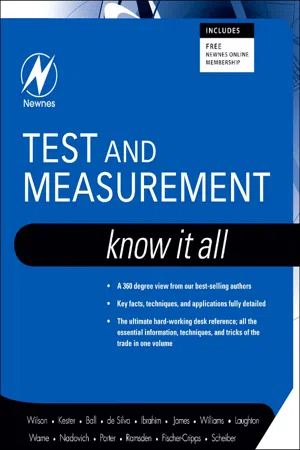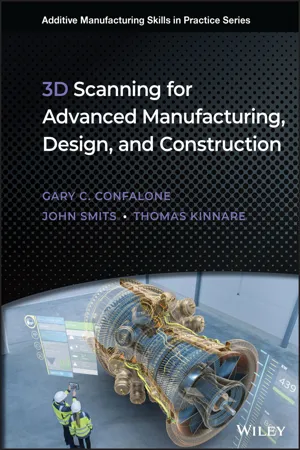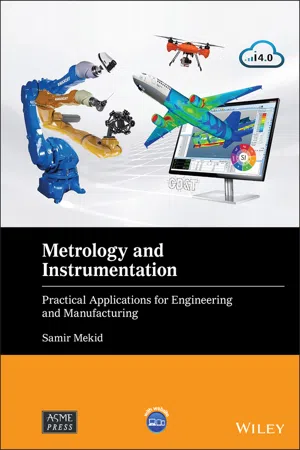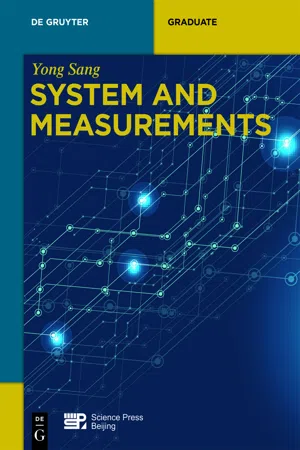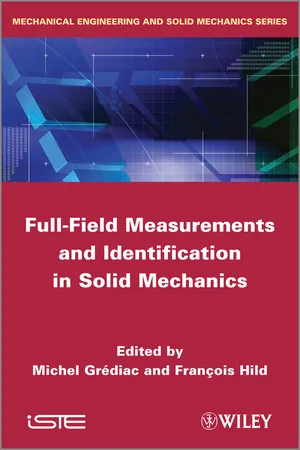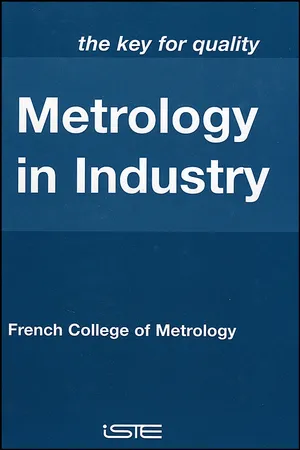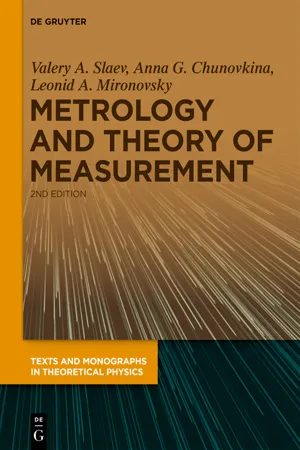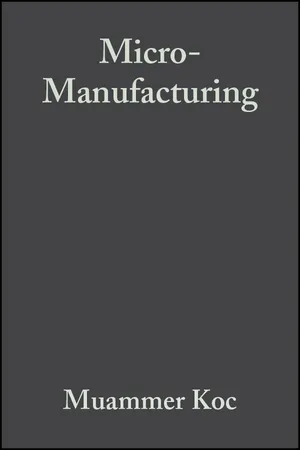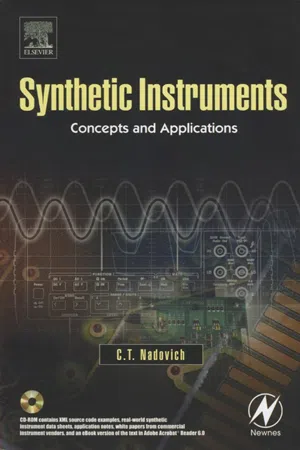Technology & Engineering
Metrology
Metrology is the science of measurement, encompassing both theoretical and practical aspects. It involves the development and application of measurement standards, techniques, and instruments to ensure accuracy and precision in various fields such as manufacturing, engineering, and science. Metrology plays a crucial role in quality control, process optimization, and the advancement of technology.
Written by Perlego with AI-assistance
Related key terms
Related key terms
1 of 4
Related key terms
1 of 3
10 Key excerpts on "Metrology"
- eBook - ePub
- Jon S. Wilson, Stuart Ball, Creed Huddleston, Edward Ramsden, Dogan Ibrahim(Authors)
- 2008(Publication Date)
- Newnes(Publisher)
Part I. Measurement Technology and Techniques
Passage contains an image
Chapter 1. Fundamentals of Measurement
1.1. Introduction
Metrology, or the science of measurement, is a discipline that plays an important role in sustaining modern societies. It deals not only with the measurements that we make in day-to-day living, such as at the shop or the petrol station, but also in industry, science, and technology. The technological advancement of the present-day world would not have been possible if not for the contribution made by metrologists all over the world to maintain accurate measurement systems.The earliest metrological activity has been traced back to prehistoric times. For example, a beam balance dated to 5000 bc has been found in a tomb in Nagada in Egypt. It is well known that Sumerians and Babylonians had well-developed systems of numbers. The very high level of astronomy and advanced status of time measurement in these early Mesopotamian cultures contributed much to the development of science in later periods in the rest of the world. The colossal stupas (large hemispherical domes) of Anuradhapura and Polonnaruwa and the great tanks and canals of the hydraulic civilization bear ample testimony to the advanced system of linear and volume measurement that existed in ancient Sri Lanka.There is evidence that well-established measurement systems existed in the Indus Valley and Mohenjo-Daro civilizations. In fact the number system we use today, known as the Indo-Arabic numbers, with positional notation for the symbols 1–9 and the concept of zero, was introduced into western societies by an English monk who translated the books of the Arab writer Al-Khawanizmi into Latin in the 12th century.In the modern world Metrology plays a vital role to protect the consumer and to ensure that manufactured products conform to prescribed dimensional and quality standards. In many countries the implementation of a metrological system is carried out under three distinct headings or services, namely, scientific, industrial, and legal Metrology. - Gary C. Confalone, John Smits, Thomas Kinnare(Authors)
- 2023(Publication Date)
- Wiley(Publisher)
To understand 3D laser scanning technology, a person must have an understanding of Metrology. Metrology is defined as the science of measurement. It is the language that engineers use to communicate to manufacturers.When studying science, technology, engineering, and math, you will use units and the universal language of Metrology which was developed thousands of years ago and continues to evolve today. Often the parameters of these units are referred to as geometric dimensioning and tolerancing (GD&T). This language consists of formulas, numbers, and symbols that when interpreted correctly can yield the most magnificent of outcomes. It is the language of technical professionals in manufacturing and construction, or the language the designer uses to describe what he wants to the builder and end user. And once you learn this language and become indoctrinated into this world, you will see things in a different light. I often tell students to look at my coffee cup and tell me what you see. I go on to explain that everything in this classroom was designed by an engineer using a blueprint or a formula. The blueprint will dimension the cup; and the formula will define the contents. Both the blueprint and the formula use Metrology to make sure they are built to the design specifications or the proper recipe.So, you may ask, what does this have to do with 3D laser scanning. This book will focus on the applications of laser scanners as they are used to measure and reproduce 3D results. Often the reproduction of these results is referred to as Reverse Engineering or As-Built documentation. Both topics will be explored in the subsequent text.1.2 THE HISTORY OF Metrology
Archeologists believe that measurement standards have been with us for over 6,000 years and probably longer. With the adoption of agriculture to what was once a nomadic species, humans needed a way to measure their land and crop yields to communicate fair trade to others. But measurement was not only limited to the agricultural industry, free trade also created a need for measurement in all facets of life in a growing industrial world market. This of course resulted in a wide variety of measurement systems being developed throughout the world.- eBook - ePub
Metrology and Instrumentation
Practical Applications for Engineering and Manufacturing
- Samir Mekid(Author)
- 2021(Publication Date)
- Wiley-ASME Press Series(Publisher)
This considers explicit and internationally accepted definitions, principles and standards. The fundamentals of Metrology are valid for all science and engineering fields constantly looking for the best design technologies that minimize direct involvement of humans in measurement processes. The purpose of any measurement system is to provide the user with a numerical value corresponding to the variable being measured by the system as simple as the one in Figure 13.2. Metrologists consider measurement as a complex structured process in which a measurement task is carried out by applying theoretical and methodological principles and by executing agreed procedures and techniques (methods) for data generation. The measurement task must be defined by specifying the objects under measurement, the property of interest, and more importantly, the measurands. The collected data can be either displayed for real‐time analysis or stored (Fig. 13.2). Figure 13.3 exhibits the characteristics of typical sensors and ADCs mean that the data acquisition part of a typical modern instrumentation system can be split into the three functional blocks, a sensor, signal conditioning circuits, and an ADC. The digital output from the ADC can then be processed in a programmable digital processor to extract information that can be displayed to an operator, stored in a memory, transmitted via a data link, or used in feedback control. The costs of all the components are continually falling - eBook - ePub
- Yong Sang(Author)
- 2020(Publication Date)
- De Gruyter(Publisher)
Measurement and Control (published by Softmotor Ltd., UK), Journal of Applied Measurement (published by JAM Press, USA), Measurement Science Review (published by Slovak Academy of Sciences – Inst. Measurement Science, Germany), Measurement Techniques (published by Springer New York LLC, USA), Metrology and Measurement Systems (published by Polish ACAD Sciences Committee Metrology and Res Equipment, Poland), Transactions of the Institute of Measurement and Control (published by SAGE Publications Ltd, UK), Flow Measurement and Instrumentation (published by Elsevier Ltd, UK), Measurement: Journal of the International Measurement Confederation (published by Elsevier B.V., Netherlands), Radiation Measurements (published by Elsevier Ltd, UK) and others. Monographs, handbooks and booklets both in specific fields and on general problems of measurement technology and instrument-making are also published. 1.2 Basic concepts of measurement technology Measurement technology is indispensable in the production process, experimentation and scientific research, and it plays the role of human senses. It is an important part of automated machining. The state and data of the production process are obtained through measurement technology. In many developed countries, despite the high level of instrument manufacturing technology, measurement technology is still highly valued. Figure 1.1 shows an alcohol-in-glass thermometer. This alcohol-in-glass thermometer consists of a glass capillary labeled with Celsius or Fahrenheit. Alcohol expands or contracts with temperature to increase or decrease the level of liquid, thereby indicating the temperature. This thermometer is a simple system with only one module and no electronic conversion and analysis circuitry in the system. The change in temperature will be translated directly into a change in liquid volume - Michel Grediac, Francois Hild, Michel Grediac, Francois Hild(Authors)
- 2012(Publication Date)
- Wiley-ISTE(Publisher)
1.2. Terminology: international vocabulary of Metrology
1.2.1. Absolute or differential measurementIn any scientific domain, terminology is essential. Rather than enumerating the main terms to use (precision, sensitivity, resolution, etc.), let us try to adopt the final user point of view. What are the questions he generally asks, and in which context? There are, in fact, not so many questions, and each of them leads naturally to the relevant metrological term(s):1) Is the obtained result “true”, “exact” and “close to reality”? How to be confident in the result? 2) Is the equipment “sensitive”? Does it see small things?These two questions lie behind the separation of Metrology into two distinct domains, within which the metrological approach will be different: absolute measurement and differential measurement.1.2.1.1. Absolute measurementHere, we seek the “true” value of the measurand (the physical quantity to measure), for example to assess that the functional specifications of a product or system are met. Dimensional Metrology is an obvious example. The functional quality of a mechanical part will most often depend on the strict respect of dimensional specifications (e.g. diameters in a cylinder/piston system). The user is interested in the deviation between the obtained measurement result and the true value (the first of the two questions above). This deviation is called the measurement error. This error is impossible to know, and here is where Metrology comes in. The approach used by metrologists is a statistical one. It will consist of evaluating the statistical distribution of the possible errors, and characterizing this distribution by its width, which will represent the average (typical) deviation between the measurement and the true value. We generally arrive here at the concept of measurement uncertainty,- eBook - ePub
Metrology in Industry
The Key for Quality
- Dominique Placko, Dominique Placko(Authors)
- 2013(Publication Date)
- Wiley-ISTE(Publisher)
– make it your business, first and foremost, to define the real needs of the firm; this is the most difficult step, but the most momentous because it will give the company a choice of solutions and consequently lead to a budget. You have to adapt yourself to today’s needs, but remain aware of what tomorrow will be. Thinking ahead is certainly not reprehensible.There is a real need to define the physical or chemical quantities, as well as the characteristics of the products that the firm is to measure, to set the measuring ranges, and to define the measurement uncertainties with regard to the requirements of a standard of products, of the method of testing or of any other criteria which have to be complied with.3.2. Goals and role of the measurement management system — metrological function
The EN ISO 10012 standard introduces the concept of a “measurement management system” and defines it as a set of interrelated or interacting elements necessary to achieve a metrological confirmation and a continual control of measurement processes. Therefore:– the metrological confirmation of the measuring equipment must be seen; – a control of the measurement processes must be organized.The first point (the metrological confirmation of the measuring equipment) represents the traditional activity of the Metrology function of firms as it was conceived a few years ago. The continuous control of the measurement processes has been added to this typical activity of management of a set of instruments.This developments has led to a new definition of the metrological function. It is to be found at paragraph 3.6 of the EN ISO 10012 norm: “Function which is administrative and technical responsibility for defining and implementing the measurement management system.”Consequently, the metrological function will be responsible for the metrological confirmation of the measuring equipment. This operation is defined as follows: - eBook - ePub
- Valery A. Slaev, Anna G. Chunovkina, Leonid A. Mironovsky(Authors)
- 2019(Publication Date)
- De Gruyter(Publisher)
In this connection it would be correct to consider separately the problem of metrological accompaniment of the software for measurement results processing. A documented standard [ 195 ] briefly formulates the basic metrological requirements for a software, related to the availability of a detailed documentation, protection of the software, its univocal identification and adequacy for application under conditions in measurement, test, and calibration laboratories. Adequacy in the metrological sense is understood, firstly, as the possibility of achieving the required accuracy of a final result of measurement when a particular software is used. When we speak of the accuracy characteristics of the algorithms and software used in Metrology, we need to pay attention to the uncertainty components of errors and toe methods for their evaluation. The accuracy of final measurement results is influenced by various factors, such as the accuracy of the input data, the algorithm of the input data processing, the algorithm of the evaluation of a final result, as well as the realization of the listed algorithms in the software. In 1980s, at the D. I. Mendeleyev Institute for Metrology (St. Petersburg, Russia) the methodology for the certification of algorithms for data processing in carrying out measurements was developed [ 332 ]. The certification of an algorithm (software) of data processing is an investigation of the algorithm properties with the help of models of initial data which results in the determination of properties and he evaluation of quantitative characteristics of the algorithm (software). However, there is a difference between the procedures of the general and metrological certification - eBook - ePub
Micro-Manufacturing
Design and Manufacturing of Micro-Products
- Muammer Koç, Tugrul Özel, Muammer Koc, Tugrul Özel(Authors)
- 2011(Publication Date)
- Wiley(Publisher)
Chapter 4 Metrology, Inspection, and Process Control in Micro-scales Omkar G. Karhade Intel Corporation, Chandler, Arizona Thomas R. Kurfess International Center for Automotive Research, Clemson University, Clemson, South Carolina 4.1 IntroductionAdvances in micro-machining technology have enabled the design and development of ever smaller and complex miniaturized products. To address this miniaturization requirement, smaller dimensions, precise material properties, precise fabrication, stress-free components, and high reliability are being targeted. Various Metrology techniques are used for the measurement of these properties. These techniques are critical also during component fabrication for monitoring production processes, to ensure a high yield.Quantification of these properties is very challenging as the measurement needs to be taken on a micro-scale. On a micro-scale, the properties of material differ from those of the bulk material. Furthermore, dimensional precision required for micro-machined parts is more stringent as the overall dimensions are reduced. Fabrication techniques are also significantly different from bulk machining techniques (e.g., chemical deposition, oxidation and annealing are used in micro-machining). These techniques may introduce high stresses in different components in the micro-machined parts, which may have a significant impact on the functionality or reliability of those parts.Conventional macro-scale Metrology techniques can partially address these issues. Extensive research is being done to develop newer Metrology techniques. Some of these techniques are derived from macro-scale Metrology and some are fundamentally different from macro-scale techniques.The Metrology techniques are generally offline, meaning that the part needs to be taken out of the production line and moved to the Metrology tool in order to be measured. This has a negative impact on the production cycle time and early detection of defect cannot be achieved. Hence, significant research efforts are directed towards enabling in-line Metrology. - eBook - ePub
- Chris Nadovich(Author)
- 2004(Publication Date)
- Newnes(Publisher)
CHAPTER 8Calibration and Accuracy
Calibration and Metrology is an immense topic with numerous aspects. Calibration is particularly vital with respect to synthetic instruments because the SI is the new kid on the block and will be scrutinized carefully by expert and tyro test engineers alike. During this scrutiny, proponents of the new approach want to make sure the evaluations are fair, unbiased, and based on a valid scientific methodology.Metrology for Marketers and Managers
When somebody decides they want to buy a measurement instrument, the only thing they may know for sure right off the bat is that they want to pay as little as possible for it. But if this was the only specification for a measurement instrument, it’s doubtful anything useful would be purchased.Sometimes instrument shoppers will specify that the instrument they want to buy should be able to do whatever it does exactly like some old instrument they currently have. But assuredly, if “doing exactly what X does” is the only performance criteria, the system that best performs just like X will be X itself. That’s not likely to be what they wanted, or they wouldn’t be shopping for a replacement for X .Intelligent people shopping for measurement instruments will think about the measurements the old instruments made and make a list of the measurements they still want. They will present this list of their requirements to various vendors. In this way, they allow suppliers freedom to offer them something other than what they already have. But they don’t want to give the vendors too much freedom, so they need to specify the accuracy they need for the measurements. Customarily they get the accuracy and measurement capabilities from the specifications of X . If the new system meets these abstract specifications gleaned from the specifications of their old system X , they figure they will get something at least as good as X - eBook - ePub
- Beat Jeckelmann, Robert Edelmaier, Beat Jeckelmann, Robert Edelmaier, Beat Jeckelmann, Robert Edelmaier(Authors)
- 2023(Publication Date)
- De Gruyter Oldenbourg(Publisher)
The quality infrastructure is an essential guarantor of economic success. It is based on the interaction of Metrology, standardization, accreditation, conformity assessment, and market surveillance. Metrology is a guarantor for ensuring measurement trueness, measurement stability, and testability and strongly supports international harmonization in these areas.The digital transformation challenges the quality infrastructure in various ways. A concrete example with great impact on the economy and society is the digital transformation of the energy transition. Without smart grids, which digitally support the interaction between decentralized energy supplies, a successful energy transition will be very difficult to achieve. Reliable measurements of power consumption and grid parameters as well as their communication via digital infrastructures are an important building block in this process. Therefore, many countries have introduced so-called “ smart meters” as an important initial step in this direction. Such smart meters combine metrological requirements with security-related requirements and requirements of verification legislation. This underlines the necessity of strong interdisciplinary collaboration and effective coordination, as it requires core metrological competence as well as digital expertise.4.1 Machine-readable standards and documents in the QI
Machine readability means that the information from a document, data set, or other source can be accessed and used by a software program. This can, for instance, be achieved by using a structured document format such as XML. An XML document contains structured elements with specified names, so-called “ tags,” which in turn hold the actual content information. A schema file specifies for the software how the tags are organized, what their relation is to each other, and what type of content they contain. A simple XML document snippet could be given as follows:
Index pages curate the most relevant extracts from our library of academic textbooks. They’ve been created using an in-house natural language model (NLM), each adding context and meaning to key research topics.
Explore more topic indexes
Explore more topic indexes
1 of 6
Explore more topic indexes
1 of 4
